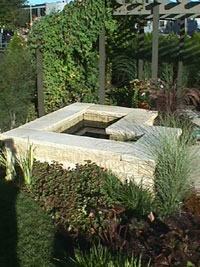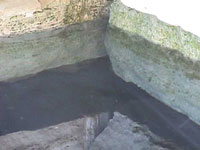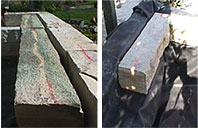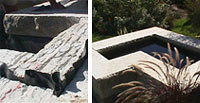






In the Better Homes and Gardens Test Garden® (built to serve the magazine, BHG.com, and projects), we installed one pond of typical design -- a kidney-shape pool, waterproofed with a liner made of one piece of plastic sheeting, and encircled by flagstones -- and another pond of highly atypical design, made by stacking limestone blocks to make an L-shaped box (see photo, right). The two ponds look so different -- one formal, one informal, one at ground level, one at seat level -- that they seem to belong in different gardens; but they share one crucial feature, which is the way the liner hides itself at the edge, eliminating an eyesore that mars too many garden ponds.
Most of the instructions for building a pond that you'll find in books and magazines share the same flaw. They tell you to dig a hole, spread the liner and let it extend out of the hole and over the ground about a foot, then place a ring of flagstones to hide the overlapping portion of the liner. Not good. Yes, you hide the part of the sheeting that laps out of the pond, but you dramatically expose the sheeting inside the pond.
When you fill a pond, you have to stop with the water an inch or two below the level of the ground. Otherwise, in a heavy rain, the pond will overflow and make a nearby bog you can't walk on (and you may find goldfish flopping on the lawn). But keeping the water below ground level means that you now you have one or two inches of liner exposed around the whole pond. Not pretty.
Liner is typically black plastic, unhandsome by itself, and at the water's edge, it soon acquires streaks and lines of the minerals left behind when evaporation takes water from the pond. Your circle of flagstones tries hard to look natural, but the hem of plastic below undoes the illusion. In most ponds, summer adds another problem. After several hot days, evaporation might have carried away another inch or two of water, leaving even more liner in view.
Add your own small, inexpensive water garden with our how-to.

Here's how we hide the pond liners in the Test Garden. The photos show the formal stone pond but the same method works on informal ponds. It also works with other materials for edging a pond, including bricks, pavers, and timbers.
The trick is to make the edging of the pond -- the flagstones, bricks, pavers or what have you -- not one layer deep but two, and then wrap the liner around the bottom layer. Now you can fill the pond within an inch or two of the top layer. The liner goes under water and stays under water, out of sight (see photo, right).

We laid up precut limestone blocks to make our formal pond, but we had to cut one stone in each course. The gas-powered saw has a diamond blade, makes a fearsome noise and lots of dust, and cuts soft stone easily (see photo, right).

We put the liner in the pond, folded and pleated it to fit the corners, and brought the surplus liner over the edge of the limestone blocks. Note that for this course of blocks, the one below the top course, we used blocks that are half the width of the other courses (see photo, near right). This way, the liner, folds over the edge of the pond and then rises between two blocks, out of sight from the garden side of the pond and out of sight from the water side of the pond (see photo, far right).
If you dig a pond in the ground, spade a shelf around the edge as deep and wide as your edgers, run the liner over the shelf, lay the bottom layer of edgers (let's say flagstones) on top of the liner, fold the liner on top of the flagstones, and then lay the final circle of flagstones on the bottom layer to hold the liner in place and hold it at the same time. Now you can't see the liner from the water side or from the garden side.

We had a lot of folds and pleats in the liner, so instead of folding the edge over the limestone blocks, we cut it off level with the top of the blocks (see photo, near right). Then we laid the top layer of blocks. They overhang the bottom layer about an inch, an elegant touch (see photo, far right).
So, when you make your own pond and waterproof it with a liner made of plastic sheeting, forget the books and magazines and do what we do in the Test Garden: fold that liner out of sight and fill 'er up.
Copyright © www.100flowers.win Botanic Garden All Rights Reserved